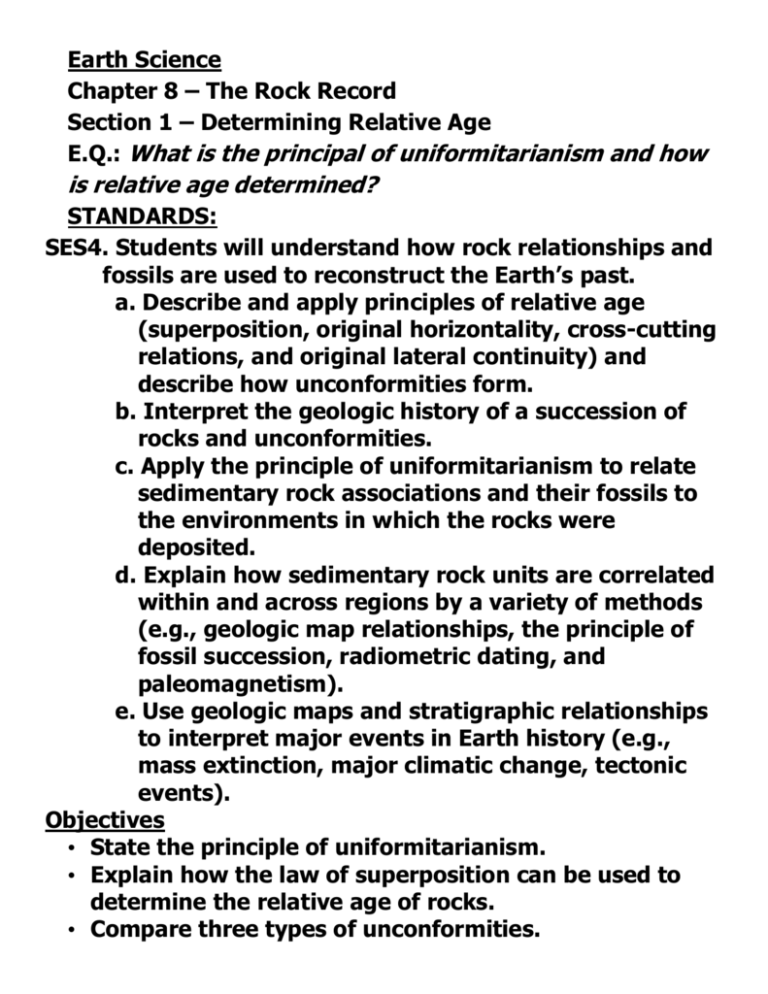Earth Science
advertisement

Earth Science Chapter 8 – The Rock Record Section 1 – Determining Relative Age E.Q.: What is the principal of uniformitarianism and how is relative age determined? STANDARDS: SES4. Students will understand how rock relationships and fossils are used to reconstruct the Earth’s past. a. Describe and apply principles of relative age (superposition, original horizontality, cross-cutting relations, and original lateral continuity) and describe how unconformities form. b. Interpret the geologic history of a succession of rocks and unconformities. c. Apply the principle of uniformitarianism to relate sedimentary rock associations and their fossils to the environments in which the rocks were deposited. d. Explain how sedimentary rock units are correlated within and across regions by a variety of methods (e.g., geologic map relationships, the principle of fossil succession, radiometric dating, and paleomagnetism). e. Use geologic maps and stratigraphic relationships to interpret major events in Earth history (e.g., mass extinction, major climatic change, tectonic events). Objectives • State the principle of uniformitarianism. • Explain how the law of superposition can be used to determine the relative age of rocks. • Compare three types of unconformities. • Apply the law of crosscutting relationships to determine the relative age of rocks. Uniformitarianism uniformitarianism a principle that geologic processes that occurred in the past can be explained by current geologic processes • Geologists estimate that Earth is about 4.6 billion years old, an idea that was first proposed by James Hutton in the 18th century. • Hutton theorized that the same forces that change Earth’s surface now, such as volcanism and erosion, are the same forces that were at work in the past. Earth’s Age • Hutton’s ideas raised serious questions about Earth’s age, because up until that time, most scientists thought Earth was only 6,000 years old, and that all Earth’s geologic features had formed at the same time. • Hutton’s ideas about uniformitarianism encouraged other scientists to learn more about Earth’s history. Reading check What evidence did Hutton propose to show that Earth is very old? Hutton reasoned that the extremely slow-working forces that changed the land on his farm has also slowly changed the rocks that make up Earth’s crust. Relative Age relative age the age of an object in relation to the ages of other objects • One way to learn about Earth’s past is to determine the order in which rock layers and other rock structures formed. • Layers of rock, called strata, show the sequence of events that took place in the past. • Scientists can determine the order in which rock layers formed by using a few basic principles. • Once they know the order, a relative age can be determined for each layer. • Relative age indicated that one layer is older or younger than another layer but does not indicate the rock’s age in years. Law of Superposition law of superposition the law that a sedimentary rock layer is older than the layers above it and younger than the layers below it if the layers are not disturbed • Scientists commonly study the layers in sedimentary rocks to determine the relative age of rocks. • Sedimentary rocks form when new sediments are deposited on top of old layers of sediment. • As the sediments accumulate, they harden into layers called beds. The boundary between two beds is called a bedding plane. • Scientists use a basic principle called the law of superposition to determine the relative age of a layer of sedimentary rock. • The law of superposition states that an undeformed rock layer is older than the layers above it and younger than the layers below it. The diagram below illustrates the law of Superposition. Principle of Original Horizontality • Scientist know that sedimentary rock generally forms in horizontal layers. • The principle of original horizontality states that sedimentary rocks left undisturbed will remain in horizontal layers. • So, scientists can assume that sedimentary rock layers that are not horizontal have been tilted or deformed by crustal movements that happened after the layers formed. Graded Bedding • In some cases, tectonic forces push older layers on top of younger ones or overturn a group of rock layers. So, scientists must look for clues to the original position of the layers. • One clue is the size of particles in the layers. In some environments, the largest particles of sediment are deposited in the bottom layers. • The arrangement of layers in which coarse and heavy particles are in the bottom layers is called graded bedding. • If larger particles are located in the top layers, the layers may have been overturned by tectonic forces. Cross-Beds • Another clue is the shape of the bedding planes. • When sand is deposited, sandy sediment forms curved beds at an angle to the bedding plane. • These beds are called cross-beds. Scientists can study the shape of the cross-beds to determine the original position of the layers. Ripple Marks • Ripple marks are small waves that form on the surface of sand because of the action of water or wind. When the sand becomes sandstone, the ripple marks may be preserved. • In undisturbed sedimentary rock layers, the crests of the ripple marks point upward. Scientists study the orientation of the ripple marks to determine the original position of the layers. Reading check How can ripple marks indicate the original position of rock layers? Because ripple marks form at the top of a rock layer, scientists can use the orientation of the ripple marks to determine which direction was “up” when the rock layers formed. Unconformities unconformity a break in the geologic record created when rock layers are eroded or when sediment is not deposited for a long period of time • Movements of Earth’s crust can lift up rock layers that were buried and expose them to erosion. • Then, if sediments are deposited, new rock layers form in place of the eroded layers. • The missing layers create a break in the geologic record, called an unconformity. • There are three types of unconformities. • A nonconformity is an unconformity in which stratified rock rests upon unstratified rock. • An angular unconformity is the boundary between a set of tilted layers and a set of horizontal layers. • A disconformity is the boundary between horizontal layers of old rock and younger, overlying layers that are deposited on an eroded surface. The diagram below illustrates the three types of unconformities. Crosscutting Relationships law of crosscutting relationships the principle that a fault or body of rock is younger than any other body of rock that it cuts through. • A fault is a break or crack in Earth’s crust along which rocks shift their position. An intrusion is a mass of igneous rock that forms when magma is injected into rock. • In these cases, scientists use the law of crosscutting relationships, or the fact that a fault or an intrusion is always younger than the layers it cuts through, to determine the order of the layers. The diagram below illustrates the law of crosscutting relationships which can be used to determine the relative ages of rock layers .








